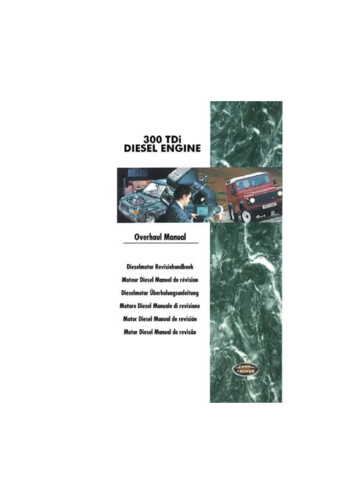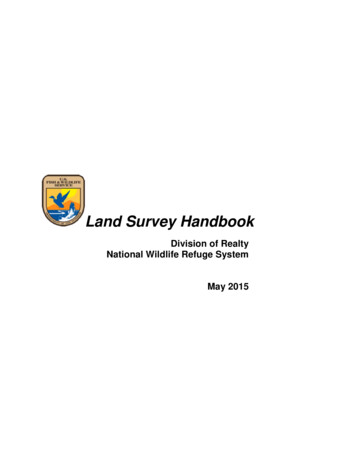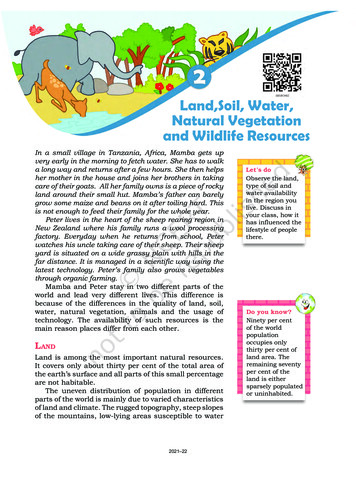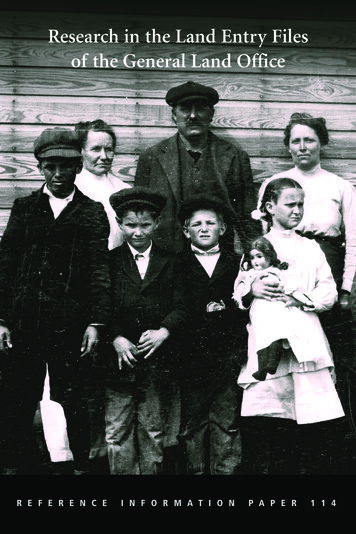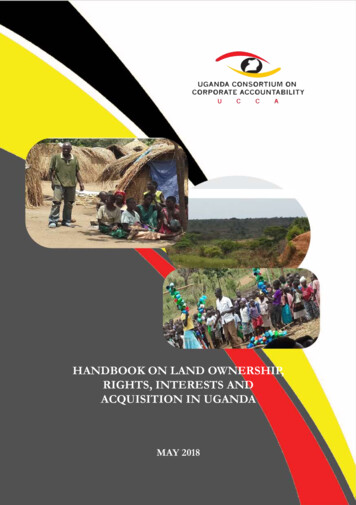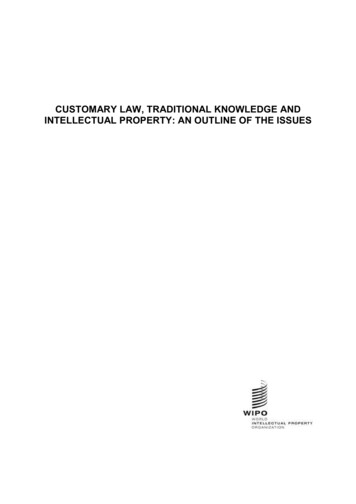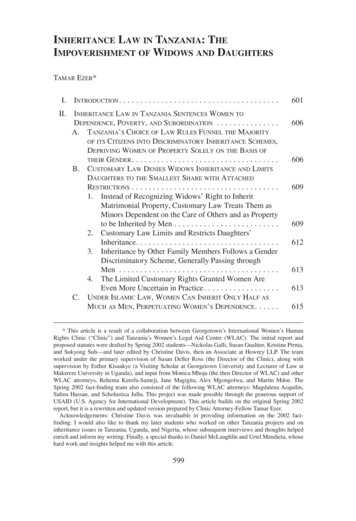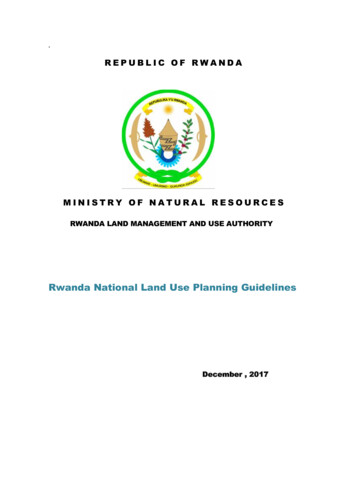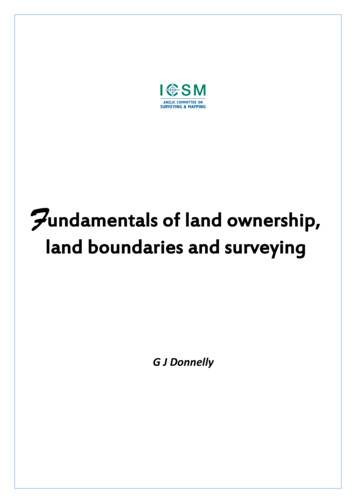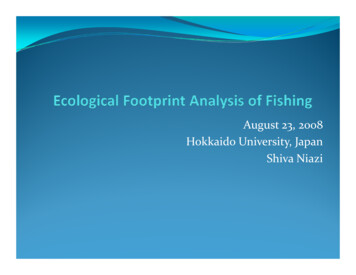
Transcription
Volume twoCase studies oncustomary landand developmentin the Pacific
Commonwealth of Australia 2008This work is copyright. Apart from any use as permitted under the CopyrightAct 1968, no part may be reproduced by any process without prior writtenpermission from the Commonwealth. Requests and inquiries concerningreproduction and rights should be addressed to the Commonwealth CopyrightAdministration, Attorney-General’s Department, Robert Garran Offices,National Circuit, Barton ACT 2600 or posted at http://www.ag.gov.au/ccaVolume twoVolume setISBNISBN978 1 921285 23 3978 1 921285 28 8Disclaimer The views expressed in this publication do not necessarilyrepresent the views of any individual or organisation involved in thePacific Land Program.Published by the Australian Agency for International Development(AusAID), Canberra, June 2008.This document is online at www.ausaid.gov.au/publicationsFor more information about the Australian overseas aid program, contact:Public Affairs GroupAusAIDGPO Box 887Canberra ACT 2601PhoneFacsimileInternet 61 2 6206 4000 61 2 6206 4695www.ausaid.gov.auDesigned by Swell Design GroupPrinted by Pirion Pty Ltd
iiiVolume twoContentsPrefaceIntroductionvviiReconciling customary ownershipand development1Incorporated land groups in Papua New GuineaTony Power2Village land trusts in Vanuatu: ‘one common basket’Jim Fingleton, Anna Naupa, Chris Ballard213Recording land rights and boundaries in Auluta Basin, Solomon IslandsJohn Cook, Genesis Eddie Kofana474Land registration among the Tolai people: waiting 50 years for titlesJim Fingleton, Oswald ToLopa655Informal land systems within urban settlements in Honiara and Port MoresbySatish Chand, Charles Yala856The role of the Central Land Council in Aboriginal land dealingsMick Dodson, David Allen, Tim Goodwin1077Maori landownership and land management in New ZealandTanira Kingi1298Absentee landowners in the Cook Islands: consequences of change to traditionRon Crocombe, Makiuti Tongia, Tepoave Araitia1533Dispute resolution9Mediating land conflict in East TimorDaniel Fitzpatrick17510 Resolving land disputes in Samoa199Jennifer Corrin11Settling customary land disputes in Papua New GuineaNorm Oliver, Jim Fingleton223
ivMAKING LAND WORK » VOLUME TWO CASE STUDIESLand for public purposes12Acquiring land for public purposes in Papua New Guinea and VanuatuMichael Manning, Philip Hughes24113Accessing land for public purposes in SamoaChris Grant265Policy reform and administration14 The paths to land policy reform in Papua New Guinea and VanuatuMichael Manning28515307Strengthening land administration in Solomon IslandsDouglas Larden, Marjorie Sullivan16 Training and educating land professionals: the value of institutional partnershipsChris Lunnay327Annex: Contributors to the case studies347
PrefacePrefaceMaking land work, produced as part of AusAID’s Pacific Land Program, has two volumes.Volume one, Reconciling customary land and development in the Pacific, is an overviewof the main issues that Pacific island countries, Papua New Guinea and East Timor—referred to broadly as the Pacific region—are likely to face if they choose to reformtheir land policies and institutions to promote social and economic development. Thisvolume, Volume two, Case studies on customary land and development in the Pacific, is acollection of 16 studies that look at problems and innovative practices in land tenure andadministration across the Pacific region.AusAID recognises that land policy reform is something that must be driven by Pacificgovernments and communities, not by donors. For this reason, Making land work does notseek to advocate any particular policy options or models. Nor does it necessarily reflectAusAID or Australian government policy. Rather, it has been published as an informationresource for countries undertaking land policy reform. It draws lessons from internationalexperience, canvasses broad principles and approaches, and seeks to stimulate ideas onpolicy options.Making land work reflects the input of some 80 experts and practitioners in land anddevelopment from the Pacific region, including Australia and New Zealand. A steeringgroup of senior representatives from government, regional organisations and civil societyin the region provided broad guidance and advice for both volumes.The annex to this volume details the process and participants in preparing the casestudies. These studies were drafted by land experts and practitioners following a topicselection and appraisal process. All but two are based on in-country research andconsultations by authors. Early drafts were reviewed by panels of officials, experts andpractitioners from the Pacific region and Australia, then revised by authors and finalisedfor publication by AusAID’s editorial team. This volume contains the edited versions ofthese second drafts produced for AusAID by the authors.1Land policy reform in the Pacific is a complex and sensitive issue. There is a wide varietyof views and perspectives held by experts and practitioners—sometimes conflicting, yetsometimes equally valid. It is neither possible nor desirable to attempt to reconcile all ofthe differing perspectives or conflicting views. While there may be disagreement by someover the content of Making land work, AusAID hopes this will encourage ongoing dialogueand debate on this important issue across the region.If Making land work contains inaccuracies or errors of fact or omission—despite the bestefforts of those involved—AusAID accepts full responsibility.1One case study, ‘The Native Land Trust Board of Fiji and development within communal tenure’, is not included in this volume as aresult of delays in agreeing to its final text. It will be published on AusAID’s website and in any reprint.v
IntroductionIntroductionMaking land workPacific governments and communities are increasingly realising there is a need tostrengthen and improve their systems for managing and using land. Since 2004 PapuaNew Guinea and Vanuatu have been developing major programs to reform land policy.Papua New Guinea has already begun implementing its own program—a long-term andsweeping initiative that aims to underpin the nation’s economic development agenda.Other political and community leaders in the region are also talking of the need to maketheir most basic asset, land, work better for national development. They recognise thatsecure land tenure and effective land administration are fundamental prerequisites forimproved living standards, better public services, increased investment, protection ofvulnerable groups (such as customary owners and women) and reduced social tensions.The issue for Pacific islanders is how to make greater use of land without giving up thecustomary laws and practices that form the fabric of their culture and societies—practicesthat for countless generations have regulated the use and management of land andensured food security. In the past, especially during the colonial period, land policy reformin most Pacific countries meant permanently taking land away from customary ownershipand imposing western forms of tenure.The two volumes that comprise Making land work are about increasing the contributionland can make to communities and the economy without removing it from customaryownership. The aim of the 16 case studies in this volume is to improve understandingacross the Pacific of how other countries in the region, including Australia and NewZealand, have dealt with land administration and customary tenure issues whilepromoting economic and social development.The case studies are not designed as policy prescriptions to be transplanted from onecountry to another. They seek to provide ideas and inspiration to Pacific governments,officials, landholders and the private sector on how options might be developed for theirown countries.vii
viiiMAKING LAND WORK » VOLUME TWO CASE STUDIESThemes of the case studiesThe case studies in this volume were researched and written in 2007. The studies draw onthe experience of countries in the Pacific region including New Zealand and Australia andare grouped by theme.The first theme, ‘Reconciling customary ownership and development’, covers a broadrange of issues, which are canvassed in eight case studies. They reveal the constraints andopportunities presented when development plans require access to land in customaryownership. They demonstrate the importance of retaining customary systems whilelinking them to the legal, economic and business development systems that are emergingas Pacific societies and economies are increasingly integrated with the wider internationalcommunity.The second theme, ‘Dispute resolution’, features in three studies that review experiencesin East Timor, Samoa and Papua New Guinea. Disputes involving land are common in theregion and are very often at the heart of serious conflict. These case studies describe someof the innovative ways in which disputes can be managed and conflict averted. They alsodemonstrate the limitations of the dispute resolution processes described.There are two studies that address the third theme, ‘Land for public purposes’. Theyanalyse issues around securing land for public use in Papua New Guinea and Vanuatu, andin Samoa. As societies and economies develop, there is increasing need for land for publicinfrastructure and services such as roads, ports, schools, hospitals, sanitation, water supplyand power generation. These studies outline the successes and problems that threecountries have experienced.The fourth theme, ‘Policy reform and administration’ is covered by three very differentstudies of aspects of land policy reform and administration. Land administration thatis well planned and resourced is essential if the goals of land policy reform are to beachieved. These studies reveal the importance of ongoing political commitment toreforming land administration, to providing sufficient resources for administering landsystems, and to building and maintaining the right skills base.
IntroductionReconciling customary land and developmentCase Study 1, ‘Incorporated land groups in Papua New Guinea’, outlines Papua NewGuinea’s experience with customary landowning groups forming bodies that have formallegal status. The study analyses the strengths and weaknesses of using this method toenable groups to make their land available for development and share the benefits.Case Study 2, ‘Village land trusts in Vanuatu: “one common basket” ’, recounts Vanuatu’sexperience with using land trusts as legally recognised bodies to make decisions onbehalf of customary landowners. The study briefly outlines the histories of two trustsand analyses their successes and problems.Case Study 3, ‘Recording land rights and boundaries in Auluta Basin, Solomon Islands’,describes a consultative process to identify the owners of an area of land in SolomonIslands suitable for growing oil palm. The study analyses the way in which the landowninggroups, who are keen to reap the potential benefits of the oil palm development,increasingly accepted the need for recording the details of land ownership andboundaries, and the successes and challenges of the process.Case Study 4, ‘Land registration among the Tolai people: waiting 50 years for titles’,provides an account of efforts to register land in East New Britain Province in Papua NewGuinea based on Tolai territorial and social units and on input from traditional leaders.It analyses the reasons why the processes used were accepted and their potential forreleasing land for productive development.Case Study 5, ‘Informal land systems within urban settlements in Honiara andPort Moresby’, describes the challenges of urban growth. It analyses how informalarrangements that have developed between settlers and landowners might beregularised for the benefit of both.Case Study 6, ‘The role of the Central Land Council in Aboriginal land dealings’, outlineshow the Central Land Council in the Northern Territory of Australia is used by traditionallandowners to conduct land dealings. It analyses the reasons for the success of thisintermediary body and discusses its relevance for a Pacific context.Case Study 7, ‘Maori landownership and land management in New Zealand’, analyses theimpact of Maori land registration in individualised parcels and recent efforts to revert tocollective ownership through incorporations and trusts.Case Study 8, ‘Absentee landowners in the Cook Islands: consequences of change totradition’, outlines how inadvertent change to customary practice has resulted in thesignificant problems of fragmented landownership and absentee landowners. It analyseshow such problems might be avoided in other contexts.ix
xMAKING LAND WORK » VOLUME TWO CASE STUDIESDispute resolutionCase Study 9, ‘Mediating land conflict in East Timor’, describes a mediation model for landconflict. Examples of how it has worked are provided and its possible applicability in othercontexts is analysed.Case Study 10, ‘Resolving land disputes in Samoa’, outlines how Samoa has built on thecustomary system for resolving land disputes by formally recognising the role of villagecouncils and establishing the Land and Titles Court. It analyses the benefits and problemsof the current system.Case Study 11, ‘Settling customary land disputes in Papua New Guinea’, describes andanalyses the efforts in 1973 to create a legislative basis for land dispute resolution thatwas significantly influenced by Melanesian custom and its subsequent failure to operateeffectively due largely to inadequate resources.Land for public purposesCase Study 12, ‘Acquiring land for public purposes in Papua New Guinea and Vanuatu’,describes experiences of accessing land for public use. The analysis focuses on theproblems that have arisen and the most potentially useful ways of dealing with them.Case Study 13, ‘Accessing land for public purposes in Samoa’, outlines the procedures usedin Samoa to acquire land for public use. It emphasises the importance of adequatelyconsulting landowners and of disseminating information.
IntroductionLand policy reform and administrationCase Study 14, ‘The paths to land policy reform in Papua New Guinea and Vanuatu’,describes recent processes to launch land policy reform in these two countries.It emphasises the importance of a well-planned and structured process of policydevelopment based on extensive community consultation and participation.Case Study 15, ‘Strengthening land administration in Solomon Islands’, describes anAustralian-funded project and analyses its strengths and weaknesses. It emphasises theimportance of such a project having local ‘ownership’ and a flexible design and flexibleactivities.Case Study 16, ‘Training and educating land professionals: the value of institutionalpartnerships’, draws on experience with an Australian-funded project in Laos that builtcapacity to train land administration professionals. The experience is analysed andconclusions are drawn for meeting training needs in the Pacific region.xi
Reconciling customaryownership and developmentCase Studies12345678Incorporated land groups in Papua New GuineaVillage land trusts in Vanuatu: ‘one common basket’Recording land rights and boundaries in Auluta Basin, Solomon IslandsLand registration among the Tolai people: waiting 50 years for titlesInformal land systems within urban settlements in Honiara and Port MoresbyThe role of the Central Land Council in Aboriginal land dealingsMaori landownership and land management in New ZealandAbsentee landowners in the Cook Islands: consequences of change to tradition321476585107129153
3Reconciling customaryownership and development1Incorporated land groupsin Papua New GuineaTony Power » Land Administration Consultant, Papua New Guinea
4MAKING LAND WORK » VOLUME TWO CASE STUDIESA snapshotIncorporated land groups in Papua New GuineaIn Papua New Guinea, legislation is in place that allows customary landgroups to use their land in the formal economy. The main vehicle for thisis a form of ‘incorporation’. Incorporation is a legal term—in this case, forwhen a customary landowning group forms a body that has legal statusunder the formal legal system. This body, or corporation, can sue and besued, hold assets in its name, hire agents, sign contracts and make rulesgoverning its internal affairs. Oil palm growers in West New Britain in PapuaNew Guinea have had great success in using this type of legal vehicle fortheir own economic benefit. But there have also been problems, particularlywhen incorporated land groups are used as vehicles for receiving royalty andcompensation payments from mining and forestry companies.The important lessons from Papua New Guinea’s experience are thatincorporated land groups:»can be an effective way for customary groups toengage in the formal economy and legal system»can help to unlock the productive potential of land but needto be supported by mechanisms to help land groups identifyand protect land in order to avoid conflict and disputes»are a convenient mechanism for receiving royalty andcompensation payments but they need to have access toreliable and impartial advice to ensure that benefits are directedtowards the economic and social development of the group»provide the flexibility and authority for communitymembers to choose how to distribute income»require the support and regulation of government toensure that they are effectively formed and managed»require mechanisms to educate and inform peopleon their functions and capabilities.
51 Incorporated land groups in Papua New GuineaContents»Introduction6»Incorporation in Papua New Guinea7»Incorporated land groups and the forestry sector8»Incorporated land groups and the petroleum industryGeneral issuesThe case of the Kutubu gas and oil fields9910»Positive outcomes in the oil palm industry12»Land administration and policy reform13»LessonsEstablish processes and support for group representation of customary landownersPromote the contribution incorporations can make to land developmentEncourage social and economic activities among members of incorporated groupsAcknowledge the flexibility within incorporated groups for distributing incomePromote good corporate governance through information, education and legal supportEnsure there is effective government regulation and support14»Appendix: ContactsMeetingsTeleconference and email18Bibliography19»1415151516161717
6MAKING LAND WORK » VOLUME TWO CASE STUDIESIntroductionPeople have occupied the land of Papua New Guinea for tens of thousands of years.Over that time they have organised themselves into groups who manage land and governthemselves by what is known as ‘custom’ or ‘traditional practices’. The principles arisingfrom custom are not written down but maintained through memory and by retellinghappenings. Because there are no written records, the rules of how land is allocated,shared and used are passed from generation to generation by retelling. Similarly, historiesare maintained by repetitive public orations of the origins of the group and marriages,births, deaths and the occupation of land. Most peoples in the Pacific region and the landsthey hold continue to be governed by custom.The modern world, however, is encroaching on the isolated peoples of the region,and customary groups are increasingly finding the need to interact with modernformal economies and legal systems. This meeting of traditional and modern worldsoften comes about because of the need for land for some type of economic or socialdevelopment—a school, health clinic, hotel or mine, or agriculture or forestry. In mostcases customary landowners like to benefit from such developments, but they also like tobenefit as a group, family, clan or tribe. At the same time they like to protect and preservetheir customary interests and rights.These wishes raise many issues and questions. How does a group that lives by customnegotiate and forge agreements with other parties such as government agencies orcompanies that operate in a formal economy and formal legal system? How are the rightsof the customary group protected when it enters into such agreements? And, how can therights of the other party to the agreement be protected?Different countries have sought different ways to answer these questions. One of themost common ways is ‘incorporation’ of the customary landowner group so that it isformally recognised as a legal body by the legal system. The incorporated land groupbecomes the representative of the tribe in the formal legal system and is able to enterinto agreements and make decisions on behalf of the customary group.As a legal vehicle, an incorporated land group can serve the customary group in anumber of ways:»protect the group’s rights and interests»explore opportunities for developing land or other assets that belong to the group»negotiate on behalf of the customary group in business, development or legal matters»assist the group in managing the use of land»receive payments such as rents and royalties on behalf of the group»distribute and/or invest rents, royalties or other income on behalf of the group»raise finance so that the customary group can invest in its own land.
1 Incorporated land groups in Papua New GuineaIncorporation raises many questions for customary groups, who have their own decisionmaking systems and traditions. Can these be preserved within a legal creation like anincorporated land group? Who represents or speaks on behalf of the group? Who makesthe decisions in the incorporated land group and what is the process by which they aremade? How are the benefits of a tourism development or a mine, for example, distributedfairly to all members of the group?Papua New Guinea has laws under which customary groups can be incorporated so thatthey can use their land in the formal economy while protecting their customary interests.But its experience shows that, even if good laws can deal with the complexities ofcustomary landownership and land tenure, problems can still arise.Incorporation in Papua New GuineaThe move to create corporations from customary landowning groups was begun togive Papua New Guineans business opportunities and involve them in the economiclife of their country. The Land Groups Incorporation Act grew from the 1973 Commissionof Inquiry into Land Matters (CILM) and the Plantations Redistribution Scheme. ThePlantation Redistribution Scheme returned the land to customary owners that had beentaken from them—alienated from them—during colonial times for use as plantations.The Commission of Inquiry believed a system that enabled the legal recognition ofcustomary land tenure must be built on traditional custom. It recommended a law bepassed that would allow customary groups to register as a legal body if they wished.Both the Business Groups Incorporation Act and the Land Groups Incorporation Act werepassed in 1974. However, another piece of legislation that should have accompanied theseActs was not presented to Parliament. This legislation would have allowed customarygroups to register their land.The process for incorporating customary groups, as described by Fingleton (2007, pp. 27–8),begins with preparing the group’s constitution, which must set out:»the name of the group»the qualifications for (and any disqualifications from) membership of the group»the title, composition and manner of appointment of the committee or othercontrolling body of the group»the way in which the group acts and the way its actions are recorded»the name of the custom under which the group acts»the details of the group’s dispute settlement authority»any limitations or conditions on the powers given to the group under the Act»any rules applicable to how the group’s affairs are conducted.7
8MAKING LAND WORK » VOLUME TWO CASE STUDIESA group submits its constitution to the Registrar of Incorporated Land, who is supposedto publicise the application and check the group’s suitability for incorporation. After anycomments or objections received have been considered, the registrar can issue a certificateof recognition. This means the group is legally incorporated, gaining legal status as acorporation with perpetual succession. Perpetual succession means that the corporatebody continues to exist after the death of any of its members and the sale of its assets.Once legally incorporated the group can sue and be sued, enter into contracts and doother things a corporation can do.The main immediate application of the Land Groups Incorporation Act was to allowcustomary groups to hold title to and manage land that had been alienated duringcolonial times and then returned to them under the Plantation Redistribution Scheme.However, this title cannot be used as security for commercial borrowing. If theincorporated land group wishes to create an asset that can be used as collateral to raisemoney from commercial financial institutions to invest in the land, it must follow theprocedures known as ‘lease and lease back’, whereby the group gives the land to the state(alienation) and then leases it back from the state. The lease becomes a tradeable assetthat can be used by the group or sold to any other entity, and is thus valuable collateral.Having title to the land, the incorporated land group can also issue leases to other groupsor individuals to use the land. If commercial financial institutions deem these leases to besecure, they can be used as collateral.Incorporated land groups and the forestry sectorThe report of the Commission of Inquiry into Land Matters stressed that incorporationshould be carried out only when there was a real need for it and when it was genuinelydesired by the customary group concerned. For some time, virtually all of the land groupsincorporated were those that had alienated plantation land returned to them. But whena Forestry Act was prepared to allow for the logging of forests on customary land, theexisting Land Groups Incorporation Act was seen by the government as an ideal vehiclethrough which timber companies could deal with landowners in areas set aside forlogging. Under the Forestry Act, the trees on the land are purchased from the owners ofthe land; the land does not change hands. Because land is only indirectly involved, nothaving title to land—or the legislation to enable them to gain title—is not a problem.The Forestry Act 1991 requires landowning groups to be incorporated under the LandGroups Incorporation Act in areas where logging companies have gained the rights to logthe forests. A Forest Management Agreement gives ownership of the trees, but not theland, to the National Forest Service, which is responsible for negotiating with the loggingcompanies. Kalinoe (2003) describes this as ‘the backdoor’ method of gaining access to theland on which forests grow. The National Forest Service is responsible for paying royaltiesand compensation to the incorporated land groups. The land group leaders are thenresponsible for distributing payments to group members.
1 Incorporated land groups in Papua New GuineaExperience shows that once the representatives of the incorporated land group havesigned the Forest Management Agreement, the National Forest Service has very littlemore to do with the incorporated land groups. No assistance is provided to the groupsto learn how to involve themselves in business opportunities offered by the timberindustry and the Forestry Act prevents landowners from negotiating directly with loggingcompanies. The National Forest Service says it lacks the funds to help land groups withtheir financial management and business opportunities. Most logging companies havenot become involved in the social and economic welfare of the people on whose land theyare cutting down trees.In 2001 a World Bank review of 32 proposed logging projects found that over 90 per centof landowners were not aware of the implications of belonging to an incorporated landgroup. Even fewer were aware of the possible economic opportunities provided by theirincorporation into a land group or the responsibilities of the group’s leaders.Incorporated land groupsand the petroleum industryGeneral issuesWhen petroleum exploration companies enter customary land they must compensatecustomary landowners for any damage to the land. If an exploitable resource such as oilor gold is discovered, landowners should benefit from possibly large amounts of moneypaid as royalties or rents, negotiated by the government. Distributing compensation androyalty payments to landowners creates a problem for the resource companies and thegovernment because they need to know whose land is involved and who the landownersare. Knowing who the real owners are is important because many people claim theyqualify as a landowner when resource rents, royalties and compensation are to be paid.Under mineral exploration and development legislation, it is the government’s primaryresponsibility to identify landowners, carry out the process of incorporating land groupsunder the Land Groups Incorporation Act and mediate between the resource developerand the land groups. But government departments have become increasingly incapableof operating effectively in rural and remote areas because of a lack of funding andstaff training. As a result these tasks have been passed on to the resource companies,who have taken on the role reluctantly so that they can expedite their projects.This has led to landowners thinking it is the responsibility of the resource companies,not the government, to provide them with health, education and other services normallyprovided by government (Power 2000a, pp. 86–7).9
10MAKING LAND WORK » VOLUME TWO CASE STUDIESAn account of how the incorporation process worked on the Kutubu petroleumdevelopment licence areas illustrates some features of land group incorporationin Papua New Guinea.The case of the Kutubu gas and oil fieldsThe US oil and gas exploration company Che
Preface Making land work, produced as part of AusAID’s Pacific Land Program, has two volumes. Volume one, Reconciling customary land and development in the Pacific, is an overview of the main issues that P
